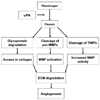The extracellular matrix: at the center of it all
- PMID: 19729019
- PMCID: PMC2824065
- DOI: 10.1016/j.yjmcc.2009.08.024
The extracellular matrix: at the center of it all
Abstract
The extracellular matrix is not only a scaffold that provides support for cells, but it is also involved in cell-cell interactions, proliferation and migration. The intricate relationships among the cellular and acellular components of the heart drive proper heart development, homeostasis and recovery following pathological injury. Cardiac myocytes, fibroblasts and endothelial cells differentially express and respond to particular extracellular matrix factors that contribute to cell communication and overall cardiac function. In addition, turnover and synthesis of ECM components play an important role in cardiac function. Therefore, a better understanding of these factors and their regulation would lend insight into cardiac development and pathology, and would open doors to novel targeted pharmacologic therapies. This review highlights the importance of contributions of particular cardiac cell populations and extracellular matrix factors that are critical to the development and regulation of heart function.
2009 Elsevier Ltd. All rights reserved.
Figures



References
-
- Davis GE, Senger DR. Extracellular matrix mediates a molecular balance between vascular morphogenesis and regression. Curr Opin Hematol. 2008;15:197–203. - PubMed
-
- Weber KT. From inflammation to fibrosis: a stiff stretch of highway. Hypertension. 2004;43:716–719. - PubMed
-
- Larue L, Bellacosa A. Epithelial-mesenchymal transition in development and cancer: role of phosphatidylinositol 3' kinase/AKT pathways. Oncogene. 2005;24:7443–7454. - PubMed
-
- Manasek FJ. Embryonic development of the heart. II. Formation of the epicardium. J Embrol Exp Morphol. 1969;22:333–348. - PubMed
Publication types
MeSH terms
Grants and funding
LinkOut - more resources
Full Text Sources
Other Literature Sources

